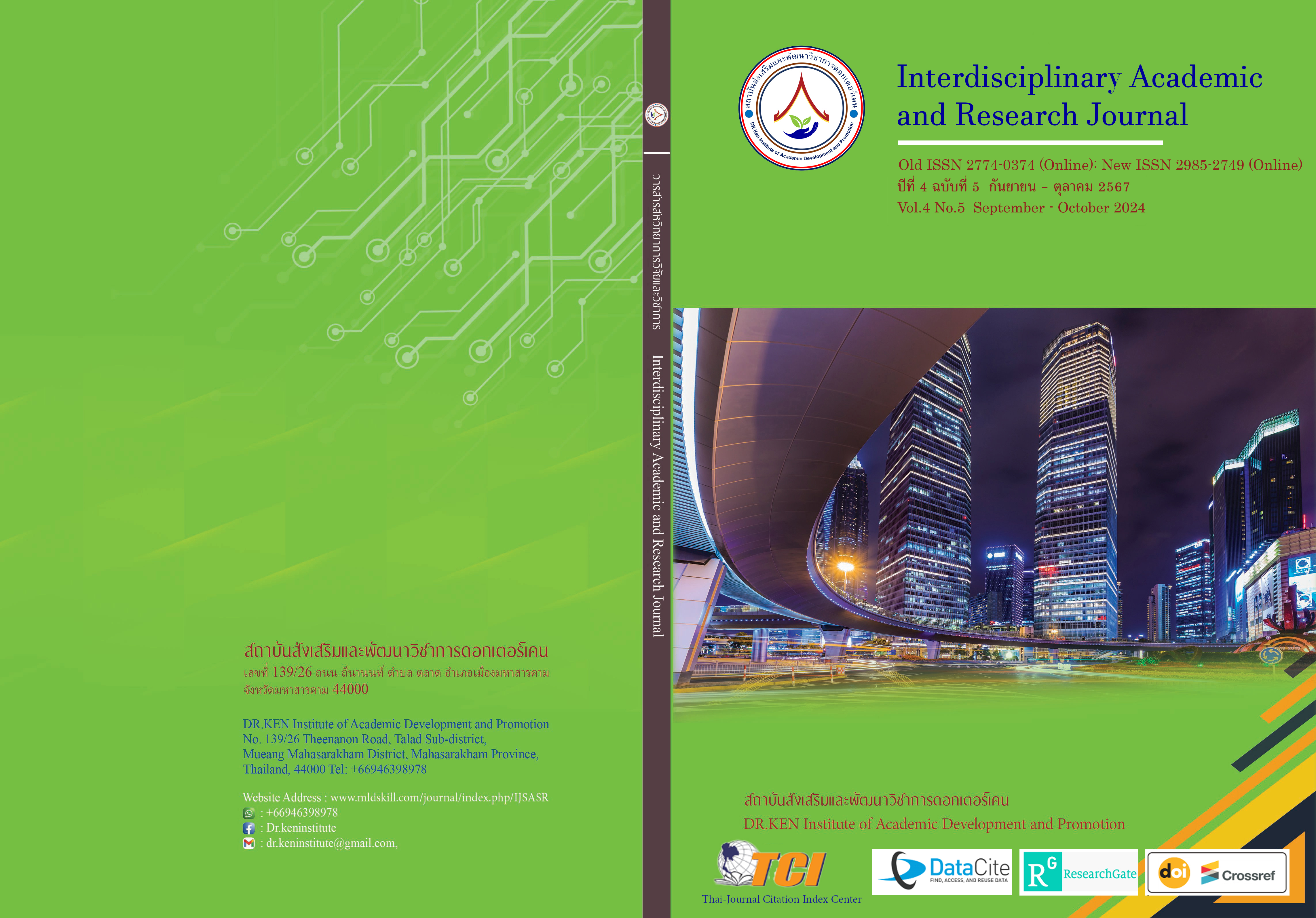The STAD Cooperative Learning Technique Combined with The STAR Strategy to Promote Problem-Solving Ability in Stoichiometry of Grade 10 Students
DOI:
https://doi.org/10.60027/iarj.2024.278041Keywords:
STAD Cooperative Learning Technique, STAR Strategy, Problem-Solving AbilityAbstract
Background and Aims: The STAD cooperative learning technique combined with the STAR strategy is a learning arrangement that promotes students’ ability to solve problems effectively, uses the STAD technique that includes teamwork and competition to create motivation for learning to solve difficult and complex problems, and uses the STAR strategy to build systematic problem-solving skills according to appropriate steps. The purposes of this research were; 1) to compare students’ problem-solving abilities after learning using the STAD cooperative learning technique combined with STAR strategy with a 70 percent criterion and 2) to study students’ satisfaction with the STAD cooperative learning technique combined with STAR strategy.
Methodology: The participants were thirty-eight grade 10 students of a school in Maha Sarakham province who were studying Chemistry 2 in the academic year 2023. The research tools included; 1) four learning management plans using the STAD cooperative learning technique combined with STAR strategy on “Stoichiometry”, totaling 12 hours, with the highest appropriateness level, 2) the subjective problem-solving ability assessment test consisting of four questions with content validity by IOC index as 1.00, difficulty index (p) ranging from 0.50 to 0.54, discrimination index (D) ranging from 0.49 to 0.51 and reliability coefficient 0.97 and 3) the satisfaction questionnaire regarding the STAD cooperative learning technique combined with STAR strategy consists of thirteen questions, each with content validity by IOC as 1.00, discrimination index (r) ranging from 0.45 to 0.75 and reliability coefficient at 0.92. The data analysis statistics were mean, standard deviation, and one sample t-test.
Results: 1) the students who received the STAD cooperative learning technique combined with the STAR strategy had problem-solving abilities higher than the 70 percent threshold with statistical significance at the .05 level and 2) the students expressed the highest level of satisfaction with the STAD cooperative learning technique combined with STAR strategy.
Conclusion: The findings show that using the STAR strategy in conjunction with the STAD cooperative learning technique enhances students' problem-solving skills and increases their enjoyment of learning. To encourage students' problem-solving skills, it is therefore recommended to combine the STAR strategy with the STAD cooperative learning technique. Moreover, by encouraging cooperative teamwork, this method aids in the social and academic growth of students.
References
กระทรวงศึกษาธิการ. (2560). ตัวชี้วัดและสาระการเรียนรู้แกนกลางกลุ่มสาระการเรียนรู้วิทยาศาสตร์ (ฉบับปรับปรุง พ.ศ. 2560) ตามหลักสูตรแกนกลางการศึกษาขั้นพื้นฐาน พุทธศักราช 2551. Retrieved from: https://www.ipst.ac.th/wp-content/uploads/2021/04/IndicatorSci2560.pdf
ทอฝัน แววกระโทก และ ผดุง เพชรสุข. (2565). การศึกษาผลสัมฤทธิ์ทางการเรียนและความพึงพอใจต่อการจัดการเรียนรู้แบบร่วมมือด้วยเทคนิค STAD รายวิชาคณิตศาสตร์ของนักเรียนชั้นประถมศึกษาปีที่ 5. วารสารนวัตกรรมการจัดการศึกษาและการวิจัย, 4(2), 27-42.
ทิศนา แขมมณี. (2559). ศาสตร์การสอน : องค์ความรู้เพื่อการจัดกระบวนการเรียนรู้ที่มีประสิทธิภาพ. กรุงเทพฯ: จุฬาลงกรณ์มหาวิทยาลัย.
ธนิสา กองเพ็ชร. (2561). การพัฒนาผลสัมฤทธิ์ทางการเรียน รายวิชาคณิตศาสตร์พื้นฐานเรื่องความคล้าย ของนักเรียนชั้นมัธยมศึกษาปีที่ 3 โรงเรียนดอนเมืองจาตุรจินดา โดยวิธีการจัดการเรียนรู้แบบร่วมมือตามรูปแบบ STAD. วิทยานิพนธ์ศึกษาศาสตรมหาบัณฑิต, มหาวิทยาลัยรามคำแหง.
บุญชม ศรีสะอาด. (2545). การวิจัยเบื้องต้น. พิมพ์ครั้งที่ 7. สุวีริยาสาส์น.
พงษ์พันธ์ พงษ์โสภา. (2542). จิตวิทยาการศึกษา. กรุงเทพฯ: พัฒนศึกษา.
ไพศาล วรคำ. (2566). การวิจัยทางการศึกษา. พิมพ์ครั้งที่ 14: ตักสิลาการพิมพ์.
รัตนพร บูรณะพล. (2564). การพัฒนาความสามารถในการแก้โจทย์ปัญหาฟิสิกส์ โดยใช้กระบวนการจัดการเรียนรู้แบบสืบเสาะหาความรู้ร่วมกับกลวิธี STAR ของนักเรียนชั้นมัธยมศึกษาปีที่ 5. วารสารครุศาสตร์ มหาวิทยาลัยราชภัฏมหาสารคาม, 15(1), 123-136.
ศุภลักษณ์ ตรีสุวรรณ. (2548). แรงจูงใจในการปฏิบัติงานของพนักงานบริษัท เอซ อินชัวรันซ์จำกัด. วิทยานิพนธ์บริหารธุรกิจมหาบัณฑิต: มหาวิทยาลัยราชภัฏสวนดุสิต.
สมาคมที่ประชุมอธิการบดีแห่งประเทศไทย. (2566). สถิติการสอบ. https://www.mytcas.com/stat
สุปราณี กิ่งนาค และ พรรณราย เทียมทัน. (2562). ผลการจัดการเรียนรู้แบบร่วมมือด้วยเทคนิคเอสทีเอดีที่มีต่อผลสัมฤทธิ์ทางการเรียนและเจตคติต่อการเรียนวิชาคณิตศาสตร์ ของนักเรียนชั้นประถมศึกษาปีที่ 4. การประชุมวิชาการระดับชาติ“ครุศาสตร์ ศึกษา ครั้งที่ 2” ในวันที่ 21- 22 มีนาคม 2562 ณ ห้องคอนเวนชั่นฮอล ศูนย์วัฒนธรรมภาคเหนือตอนล่าง มหาวิทยาลัยราชภัฏพิบูลสงคราม
American Chemical Society. (2018). Why is Chemistry Important? Retrieved from: https://www.acs.org/content/ acs/en/careers/college-to-career/chemistry-careers/why-chemistry-important.html
Luft, J.A. (2023). The Global Importance of Science Education. Retrieved from: https://www.nsta.org/blog/global-importance-science-education
National Academies. (2022). The Future of Education Research at IES Advancing an Equity-Oriented Science. Retrieved from: https://nap.nationalacademies.org/catalog/26428/the-future-of-education-research-at-ies-advancing-an-equity
Royal Society of Chemistry. (2022). Why is Chemistry Important? Retrieved from: https://www.rsc.org/campaigning-outreach/campaigning/chemistry-and-society/why-chemistry-important
Shater, A., & Shana, Z.A. (2022). The Effectiveness of Star Strategy Learning on Gifted Students’Mathematical Creative Thinking Ability. Information Sciences Letters, 12(4), 1767-1774.
Slavin, R.E. (2015). Cooperative learning: Theory, research, and practice, 3rd edition. Pearson.
Tro, N.J. (2017). Chemistry: A molecular approach. Pearson.
UNESCO. (2015). Education 2030: Incheon Declaration and Framework for Action for the Implementation of Sustainable Development Goal 4. Retrieved from: https://unesdoc.unesco.org/ark:/48223/pf0000245656
UNESCO. (2019). Education for Sustainable Development Goals: Learning Objectives. United Nations Educational, Scientific and Cultural Organization. UNESCO.
Widarti, H.R., & Amalia, E.R.F. (2024). The Implementation of Integrated Instagram Learning Media with STAD Student Teams Achievement Divisions on Increasing Learning Outcomes on The Topic of Reaction Rate. E3S Web of Conferences 481, 04002. https://doi.org/10.1051/e3sconf/202448104002
Woon, C.H., & Liu, W.C. (2016). The relationship between students’ satisfaction and learning performance in the context of active learning. Wageningen University.
World Bank. (2018). World Development Report 2018: Learning to Realize Education’s Promise. World Bank.
Downloads
Published
How to Cite
Issue
Section
License
Copyright (c) 2024 Interdisciplinary Academic and Research Journal

This work is licensed under a Creative Commons Attribution-NonCommercial-NoDerivatives 4.0 International License.
Copyright on any article in the Interdisciplinary Academic and Research Journal is retained by the author(s) under the under the Creative Commons Attribution-NonCommercial-NoDerivatives 4.0 International License. Permission to use text, content, images, etc. of publication. Any user to read, download, copy, distribute, print, search, or link to the full texts of articles, crawl them for indexing, pass them as data to software, or use them for any other lawful purpose. But do not use it for commercial use or with the intent to benefit any business.
















.png)


